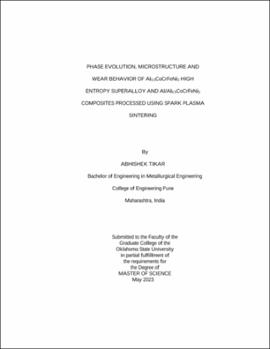| dc.contributor.advisor | Harimkar, Sandip | |
| dc.contributor.author | Tikar, Abhishek | |
| dc.date.accessioned | 2023-08-25T20:06:37Z | |
| dc.date.available | 2023-08-25T20:06:37Z | |
| dc.date.issued | 2023-05 | |
| dc.identifier.uri | https://hdl.handle.net/11244/338970 | |
| dc.description.abstract | High Entropy Superalloys (HESA), an extension of high entropy alloys, exhibit excellent high temperature properties with low density, making them a potential replacement for expensive and heavy superalloys and to be used as reinforcement in metal matrix composites. While multiple processing routes are available for high entropy alloys, spark plasma sintering is becoming increasingly popular due to its ability to fabricate alloy powder in a short period of time. Spark plasma sintering can also be used for processing metal matrix composites. This work reports the phase evolution and microstructural development of gas atomized Al₀.₅CoCrFeNi₂ high entropy superalloy powder fabricated using spark plasma sintering and, the wear properties of the sintered specimen. It also discusses the interaction of Al₀.₅CoCrFeNi₂ reinforcement particles in aluminum matrix and its effect on wear properties of the composite material. The Al₀.₅CoCrFeNi₂ alloy powder and all the specimen sintered in the range of 800℃-1050℃ showed an extremely stable single phase FCC structure. Relative density of 99% was achieved at temperatures of 1000℃ and above. Porosity pinning effect played an important role in densification process and grain growth. In all the sintered specimen, a combination of adhesive, delamination, oxidation, and abrasive wear was observed, with the coefficient of friction values recorded in the range of 0.6-0.7. Al/Al₀.₅CoCrFeNi₂ composites was sintered using spark plasma sintering with varying holding time – 10 min, 15 min, 20 min and 30 min. Specimen with holding time 15 min and above developed an interdiffusion (ID) layer at the interface of reinforcement and the matrix. The interdiffusion layer was rich in Al (60%-80%) as it diffuses inward into the HESA particle whereas Ni, Co, Cr and Fe diffuse outward into the Al matrix. Nanoindentation results showed a sudden increase in hardness in the ID layer region which is higher than that of the HESA particle the matrix. TEM images revealed the formation of Ni₃Al nanoprecipitates in the ID layer resulting in the observed increase in hardness. Formation of ID layer in the composites reduced the wear loss to almost half in comparison to pure aluminum. | |
| dc.format | application/pdf | |
| dc.language | en_US | |
| dc.rights | Copyright is held by the author who has granted the Oklahoma State University Library the non-exclusive right to share this material in its institutional repository. Contact Digital Library Services at lib-dls@okstate.edu or 405-744-9161 for the permission policy on the use, reproduction or distribution of this material. | |
| dc.title | Phase evolution, microstructure and wear behavior of al₀.₅cocrfeni₂ high entropy superalloy and al/al₀.₅cocrfeni₂ composites processed using spark plasma sintering | |
| dc.contributor.committeeMember | Sachan, Ritesh | |
| dc.contributor.committeeMember | Kalkan, A. Kaan | |
| dc.contributor.committeeMember | Vaidyanthan, Ranji | |
| osu.filename | Tikar_okstate_0664M_18181.pdf | |
| osu.accesstype | Open Access | |
| dc.type.genre | Thesis | |
| dc.type.material | Text | |
| dc.subject.keywords | aluminum matrix composite | |
| dc.subject.keywords | high entropy superalloy | |
| dc.subject.keywords | microstructure | |
| dc.subject.keywords | phase evolution | |
| dc.subject.keywords | spark plasma sintering | |
| dc.subject.keywords | wear behavior | |
| thesis.degree.discipline | Mechanical and Aerospace Engineering | |
| thesis.degree.grantor | Oklahoma State University | |
